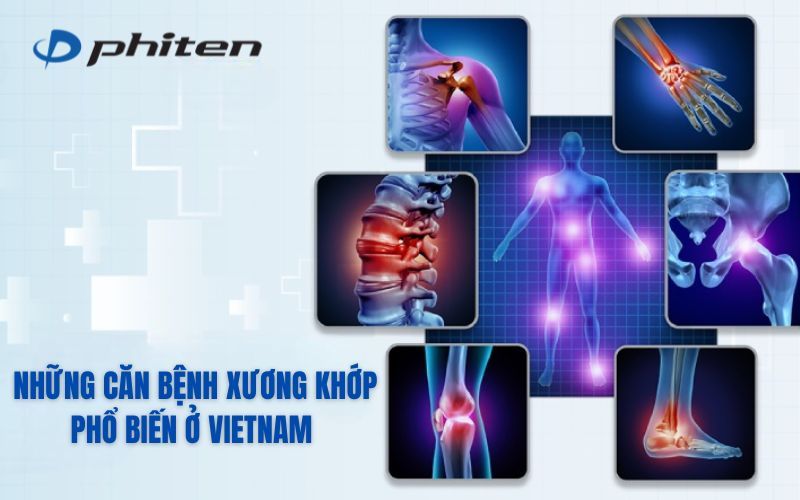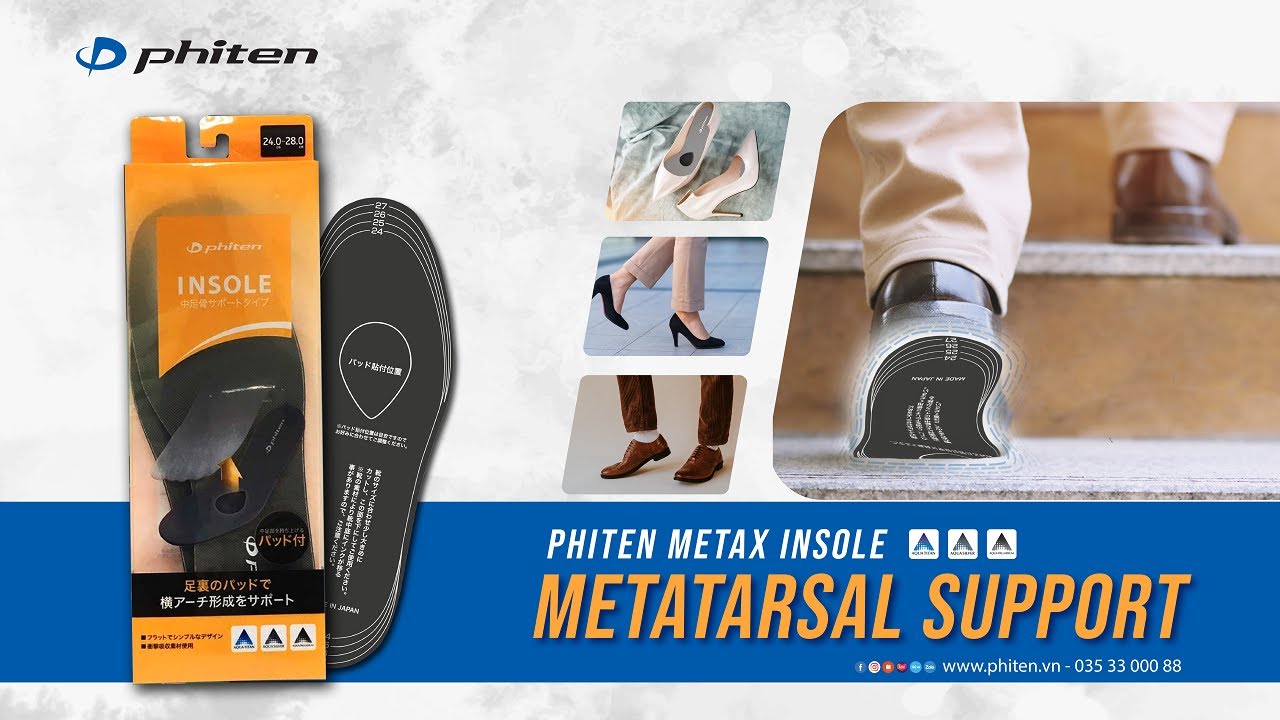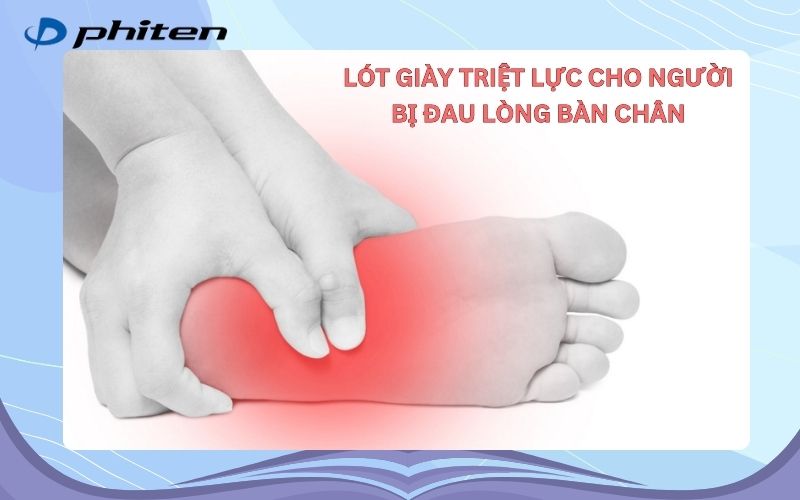Understanding Common Bone & Joint Pain in Vietnam: Causes & Information
Prioritizing bone and joint health is a vital aspect of maintaining quality of life, especially as bone and joint diseases become increasingly prevalent among Vietnamese individuals. Statistics indicate that millions of Vietnamese people are currently facing musculoskeletal issues, ranging from persistent aches to severe medical conditions.

In this article, Phiten Vietnam will share common bone and joint diseases affecting Vietnamese people, how to recognize them, their causes, and effective prevention and treatment measures.
Arthritis
Arthritis is one of the most common bone and joint diseases today. It's a condition characterized by inflammation occurring within a joint, leading to swelling, pain, and restricted mobility. Arthritis can affect any joint in the body, but it primarily impacts the knees, hands, toes, and hips.
The causes of arthritis are diverse, including genetics, age, and unhealthy lifestyle habits. A leading cause of arthritis is the damage and wear and tear of joint cartilage over time, which can easily occur when we don't pay attention to protecting our joints. Common symptoms of arthritis include aches, swelling, redness, and morning stiffness.
Arthritis treatment typically involves pain relievers, anti-inflammatory medications, and in severe cases, surgery may be an option. However, prevention is crucial. Maintaining a healthy weight, exercising regularly, and avoiding excessive physical activity can minimize the risk of developing the disease.
Osteoarthritis
Osteoarthritis, also known as degenerative joint disease, is a prevalent condition among older adults, particularly those over 50. As we age, the cartilage in our joints wears down and loses its ability to cushion movement. This leads to the ends of bones rubbing together, causing pain, stiffness, and difficulty in mobility.
Risk factors for osteoarthritis include being overweight or obese, genetics, and previous joint injuries. Additionally, irregular physical activity or excessive physical exertion over extended periods can also contribute to an increased risk of developing the condition.
Symptoms of osteoarthritis primarily involve joint pain, especially after significant activity or during changes in weather. While there is no cure for osteoarthritis, treatments such as pain medication, physical therapy, and joint replacement surgery can help alleviate pain and restore mobility.
Spinal Osteophytes
Spinal osteophytes, commonly known as bone spurs, are small bony projections that develop on the vertebrae of the spine. This condition primarily occurs due to the aging process and can cause pain and stiffness in the back. Factors such as being overweight or obese, a sedentary lifestyle, and poor posture during work or sleep can increase the risk of developing spinal bone spurs.
A particularly dangerous aspect of spinal bone spurs is that individuals may not experience any obvious symptoms. However, sometimes a persistent, dull ache can suddenly become severe if left untreated. Early diagnosis through X-rays or MRI scans is crucial for identifying the condition. Common treatment methods include physical therapy, pain medication, and in some cases, surgery.
Back pain
Back pain is one of the most prevalent issues related to bone and joint health. Vietnamese individuals have a tendency to experience this condition due to habits like prolonged sitting, bending over, or lifting heavy objects incorrectly. Back pain can stem from various causes, including poor habits, injuries, and spinal degeneration.
Back pain can appear suddenly or persist for extended periods, significantly impacting quality of life. To prevent and manage back pain, you should maintain proper sitting posture, engage in gentle exercises to strengthen back muscles, and limit chronic back pain. Additionally, consulting a doctor when back pain persists is crucial to avoid serious complications.
Herniated Disc
A herniated disc, also known as a slipped or ruptured disc, is a condition where the intervertebral disc tears or bulges out, putting pressure on nearby nerves and causing pain and numbness. This condition is common among office workers who sit for long periods or individuals whose jobs involve heavy lifting.
Typical symptoms of a herniated disc include back pain, pain radiating down the leg (sciatica), numbness, or muscle weakness. To treat a herniated disc, in addition to using pain relievers and anti-inflammatory medications, methods such as physical therapy and surgery may be employed depending on the severity of the condition.
Tendonitis
Tendonitis is a condition characterized by inflammation of the tendons, which are the fibrous cords that connect muscle to bone. When tendons become inflamed, individuals experience pain, tenderness, and may lose normal range of motion. This is a common musculoskeletal disorder, particularly among those who perform heavy manual labor, engage in frequent physical activity, or execute repetitive movements, such as in sports.
The causes of tendonitis can include overuse, repetitive strain injuries, or even the natural aging process of the body. Some common symptoms include pain when moving the affected area and swelling. Treatment for tendonitis typically involves rest, applying ice packs or heat packs, and may require the use of anti-inflammatory medications to reduce pain and swelling.
To prevent tendonitis, practicing proper sports techniques and strengthening muscles can help reduce the stress on tendons. Additionally, paying attention to rest and avoiding prolonged periods of repetitive movements are also very important.
Osteoporosis
Osteoporosis is a condition in which bones become thin and fragile due to a decrease in bone density. This is a common disease in older adults, especially postmenopausal women. Osteoporosis often progresses silently, without any obvious symptoms until a bone fracture occurs.
Risk factors for osteoporosis include genetics, a lifestyle lacking sufficient calcium and Vitamin D, and hormonal imbalances, particularly during menopause in women. Symptoms may not appear until individuals experience minor injuries, such as fractures from falls or even without significant impact. To treat and prevent osteoporosis, individuals need to increase their intake of calcium and Vitamin D and engage in bone-strengthening exercises like walking, weight training, or low-impact activities.
A balanced diet rich in calcium-rich foods such as milk, cheese, seafood, and green leafy vegetables are crucial factors in preventing osteoporosis. Find more information on effective osteoporosis prevention measures for women.
Joint stiffness
Joint stiffness is a common symptom that can occur at any age but is particularly prevalent and impactful in older adults. This condition often arises when the muscles and ligaments surrounding the joints become tight or lose their flexibility. When joints are stiff, individuals may experience pain, difficulty moving, and a reduced range of motion.
The causes of joint stiffness can include osteoarthritis, arthritis, or factors such as being overweight and a sedentary lifestyle. To treat joint stiffness, individuals need to combine physical therapy with exercises that help improve joint flexibility. Additionally, stretching exercises, especially gentle yoga routines, can also help individuals reduce pain and improve overall body flexibility.
Adopting an active lifestyle with gentle exercises, a healthy diet, and maintaining a healthy weight will help minimize joint stiffness.
Gout
Gout is a specific form of arthritis that occurs when there is a high level of uric acid in the body, leading to the formation of urate crystals that deposit in the joints. These crystals can cause severe pain attacks, particularly in the joints of the big toe, wrist, and knee. Gout commonly affects individuals with diets rich in red meat, seafood, and alcohol, which are foods that increase uric acid levels in the blood.
Symptoms of gout include intense joint pain, swelling, and redness in the affected joint, often occurring suddenly at night. Gout treatment involves pain relievers, anti-inflammatory medications, and in some severe cases, medication to lower uric acid levels in the body may be necessary. However, lifestyle changes, particularly reducing the consumption of purine-rich foods, increasing water intake, and maintaining a stable body weight, are crucial measures for managing gout. If you are experiencing similar issues, please refer to our helpful article on the causes and prevention of plantar fasciitis.
Conclusion
Bone and joint diseases are a growing health concern, especially in Vietnam where an increasing proportion of the population is affected. However, we can absolutely prevent or minimize the impact of these conditions through a healthy diet, regular exercise, and maintaining a positive lifestyle. Early detection and timely treatment will help minimize harm and improve quality of life.
If you are experiencing any bone and joint issues, don't hesitate to seek advice and timely treatment from specialists. Protecting your bone and joint health not only helps you live healthily but also helps you maintain flexibility and mobility throughout your life.
Frequently Asked Questions (FAQs) About Bone and Joint Health
1. Can tendonitis be treated with natural methods?
Tendonitis can be managed with natural methods like rest and applying ice or heat. However, in severe cases, a doctor may prescribe anti-inflammatory medication or recommend surgery.
2. Can osteoporosis be detected early?
Osteoporosis often doesn't present obvious symptoms but can be detected through bone density tests like a DEXA scan.
3. What can I do to reduce osteoarthritis pain?
To alleviate osteoarthritis pain, you can use pain relievers, perform physical therapy exercises, and maintain a healthy weight.
4. Is gout a dangerous condition?
Gout can lead to serious complications such as chronic arthritis or joint destruction if left untreated.
5. How can I prevent joint stiffness?
To prevent joint stiffness, you should exercise regularly, perform stretching exercises, and maintain a healthy meal.















